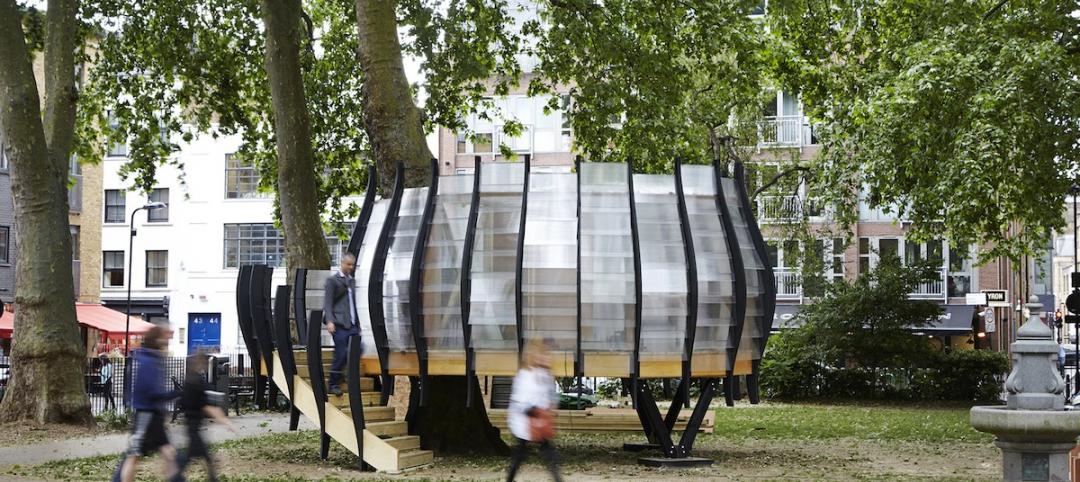As coastal flooding becomes the "new normal," many shoreline cities are trying to find long-term strategies to cope with extreme weather events. In order to advance understanding of this issue, The Boston Harbor Association teamed up with Sasaki Associates to produce Preparing for the Rising Tide, a series of reports focusing on Boston and rising sea levels.
Volume Two of this series was published in August 2014, and focuses on Designing with Water for flood management. According to the report, this school of thought "considers coastal flooding not only a threat, but an opportunity to address multiple goals while making necessary new investments in our buildings, communities, and infrastructure."
The new report contains 12 case studies of cities around the world that have applied advanced flood management techniques. In these case studies, five key design principles emerged:
1. Design for resilience. Resilience implies adapting to or bouncing back from a disturbance quickly. Resilient planning and design incorporates redundancy and anticipates change over time.
2. Create double-duty solutions. Double-duty solutions provide multiple benefits to maximize economic, ecologic, and cultural gain.
3. Strengthen community resilience. Community resilience maintains and enhances the cultural identity that defines a city through resiliency networks and social support systems. Strategies that strengthen social resilience can both cost less and provide meaningful benefits to participants.
4. Incentivize and institutionalize preparedness. Citywide and regional adaptation plans are necessary to guide resiliency efforts. Insurance standards, zoning laws, construction codes, and policy are tools that local and state governments should consider to encourage adaptation within their communities.
5. Phase plans over time. Designing with Water requires design and planning for flexibility and adaptability over time. Planning efforts that address sea level rise should be phased and have the ability to change based on external conditions.
The report concludes with recommended courses of action for members of both the private and public sectors. Here are some of the recommendations that we found particularly interesting:
Recommendations for the Private Sector:
-
Create time-phased preparedness plans based on environmental triggers such as sea level or storm intensity to maintain or even reduce risk of flood damage over time. Incorporate flood preparedness into capital maintenance schedules to minimize additional costs.
-
Look for opportunities to combine flood control with other business and institutional goals such as energy efficiency, sustainability, and livability. Coordinate such strategies with neighboring properties to provide more effective, less costly solutions.
-
Develop and teach curricula focused on Designing with Water and other flood preparedness concepts. Local design schools could be a resource.
Recommendations for the Public Sector:
-
In order to limit costly delays, dead-end investments, and exacerbated social inequalities, we strongly recommend the city of Boston and surrounding communities develop a phased master plan that protects our people and places over time as the tide rises.
-
Work with surrounding municipalities—especially those closely connected through transportation, power, water, and sewage—to develop the political will, regional planning, and resources needed to prepare for chronic coastal flooding.
-
Secure significant new public and private investment to implement the master plan and accelerate private actions. Identify an appropriate coordinating body to manage these resources most effectively to address multiple goals.
Read the full report here.
Related Stories
BIM and Information Technology | Jun 21, 2015
11 tips for mastering 3D printing in the AEC world
Early adopters provide first-hand advice on the trials and tribulations of marrying 3D printing with the science of building technology.
Events Facilities | Jun 19, 2015
4 ways convention centers are revamping for the 21st century
Today's convention centers require more flexible spaces, the ability to blend virtual and in-person events, and meaningful sustainability, writes Skanska's Tom Tingle.
Engineers | Jun 18, 2015
Architecture and engineering profit margins deliver third consecutive year of growth
Operating profits of AE firms have reach their highest level since 2009, according to a new report by PSMJ Resources.
Architects | Jun 17, 2015
Starchitects' napkin sketches raise thousands for San Diego’s AIAS chapter
Prominent architects who submitted a total of 23 napkin doodles were Zaha Hadid, Cesar Pelli, Robert Venturi, Massimiliano Fuksas, Thom Mayne, and Bjarke Ingels.
BIM and Information Technology | Jun 16, 2015
What’s next for 3D printing in design and construction?
The 3D printer industry keeps making strides in technology and affordability. Machines can now print with all sorts of powderized materials, from concrete to chocolate.
Office Buildings | Jun 12, 2015
Houston's energy sector keeps office construction humming
Colliers International projects continued expansion this year in its quarterly report on national office market.
Smart Buildings | Jun 11, 2015
Google launches company to improve city living
The search engine giant is yet again diversifying its products. Google has co-created a startup, called Sidewalk Labs, that will focus on “developing innovative technologies to improve cities.”
Office Buildings | Jun 11, 2015
Pop-up tree-office opens in London borough of Hackney
London's Hackney borough welcomed a new kind of workspace to Hoxton Square—the TreexOffice.
Cultural Facilities | Jun 10, 2015
Artists turn oil tankers into architecture
Four Dutch artists propose transforming tankers into monuments with mixed-use space.
Office Buildings | Jun 9, 2015
Bjarke Ingels unveils stepped design for final WTC tower
The towering "staircase" will rise from St. Paul’s chapel to the skyline, leaning against One World Trade Center.

















